Unique UAB Programs Prepare Students for Hot Careers
By Tara Hulen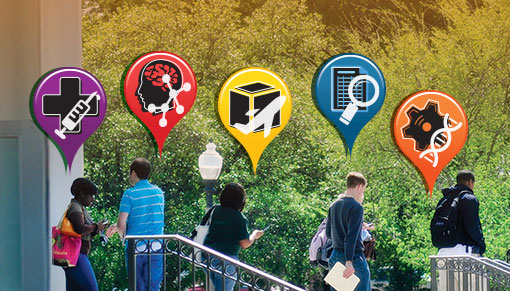 Tiffany Holloway found her niche in a sweet spot between cells and sales. As a high school student, she explored materials sciences, biology, and other disciplines in a program run by UAB's Center for Community OutReach Development. For a career, however, she wanted to balance the challenge of science with an outlet for her outgoing personality. "I was looking for something that involves people and problem solving," says Holloway.
Tiffany Holloway found her niche in a sweet spot between cells and sales. As a high school student, she explored materials sciences, biology, and other disciplines in a program run by UAB's Center for Community OutReach Development. For a career, however, she wanted to balance the challenge of science with an outlet for her outgoing personality. "I was looking for something that involves people and problem solving," says Holloway.Her search led to just one place: UAB, the only university in Alabama—and one of just two in the Southeast—offering an industrial distribution program. In addition to being unique, the program is also the entryway into a booming field. Holloway is gaining a blend of business and engineering expertise that will help the UAB junior enter a $4 trillion field with plentiful job opportunities.
Industrial distribution is one of several UAB undergraduate programs that are packed with potential—and which can't be found anywhere else in Alabama. Take a closer look at five:
1. Neuroscience
John Decker was seduced by the mysteries of the brain because "It's a relatively young field, and there are a lot of good questions that are unanswered." But the freshman from Bangor, Pennsylvania, had a limited number of options when it came to majoring in neuroscience as an undergraduate. UAB's Undergraduate Neuroscience Program attracted him because of its small size. "I felt that would mean more one-on-one advising from professors and more help getting into research labs," Decker says.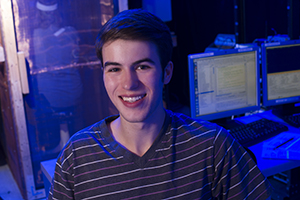 Freshman John Decker is studying how the brain processes neural stimuli in the lab of UAB vision science researcher Paul Gamlin. The Undergraduate Neuroscience Program was introduced in 2009 and is co-sponsored by the School of Medicine and College of Arts and Sciences. "The demand has been overwhelming," says program co-director Carl McFarland, Ph.D., professor in the Department of Psychology. "We are receiving applications from across the nation, and many are among the nation's best students." Although the program requires an ACT score of at least 30 and a high school GPA of 3.75 or better, the demand was such that 40 new freshmen were admitted in 2013, McFarland says. (The average ACT for new students is 32 and the average GPA is 4.20, he adds.) Despite that growth, McFarland still serves as academic advisor to all neuroscience students.
Freshman John Decker is studying how the brain processes neural stimuli in the lab of UAB vision science researcher Paul Gamlin. The Undergraduate Neuroscience Program was introduced in 2009 and is co-sponsored by the School of Medicine and College of Arts and Sciences. "The demand has been overwhelming," says program co-director Carl McFarland, Ph.D., professor in the Department of Psychology. "We are receiving applications from across the nation, and many are among the nation's best students." Although the program requires an ACT score of at least 30 and a high school GPA of 3.75 or better, the demand was such that 40 new freshmen were admitted in 2013, McFarland says. (The average ACT for new students is 32 and the average GPA is 4.20, he adds.) Despite that growth, McFarland still serves as academic advisor to all neuroscience students.
Neuroscience is one of the most rapidly advancing fields of research and training, and the program's graduates find careers in high-demand fields such as academic or government research, medicine, and biotechnology. "Job prospects for the next 10 years are excellent," says McFarland. More than 90 percent of UAB neuroscience graduates who have applied to medical or graduate school have been accepted, he notes.
The neuroscience major is an interdisciplinary program between the Department of Neurobiology—itself a joint department between the School of Medicine and the College of Arts and Sciences—and the Department of Psychology, McFarland explains. Students get the chance to interact with world-class researchers throughout their time in the major, he adds. The opening course, for example, includes lectures from nearly a dozen UAB neuroscientists, and David Sweatt, Ph.D., chair of the neurobiology department, leads a senior seminar on mechanisms of memory.
"We are training students to understand the brain, including not only its triumphs, but also its failings as seen in neurological disease," McFarland says. "Today's top students are unsurprisingly drawn into this important scientific drama."
Learn More
Find curriculum requirements and admissions info for the Undergraduate Neuroscience Program
2. Industrial Distribution
Whether you're buying a new dress, a new smartphone, or a new surgical device, someone in the booming field of industrial distribution was involved in moving it from the raw-materials stage to your local store—or local hospital. The Charles and Patsy Collat Industrial Distribution Program, a joint program of the Collat School of Business and School of Engineering, prepares graduates for sales, marketing, and purchasing positions in industrial firms.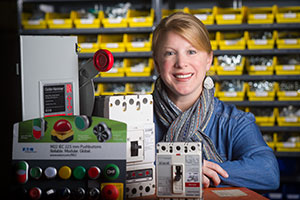 Staci Storey, a 1997 graduate of the ID program, credits her degree with "opening doors for me that I would not otherwise had access to." She landed a job with Eaton Corp. in Birmingham after graduation and now recruits from the ID program. "More than $4 trillion of the U.S. economy is based in distribution," says program director Tom DeCarlo, Ph.D., the Ben S. Weil Endowed Chair in Industrial Distribution. "More and more manufacturers are looking toward distributors to market their products so they can focus on what they do best, which is manufacture products." Many students receive multiple job offers at graduation, and job prospects in the next decade are "exceptional," DeCarlo says.
Staci Storey, a 1997 graduate of the ID program, credits her degree with "opening doors for me that I would not otherwise had access to." She landed a job with Eaton Corp. in Birmingham after graduation and now recruits from the ID program. "More than $4 trillion of the U.S. economy is based in distribution," says program director Tom DeCarlo, Ph.D., the Ben S. Weil Endowed Chair in Industrial Distribution. "More and more manufacturers are looking toward distributors to market their products so they can focus on what they do best, which is manufacture products." Many students receive multiple job offers at graduation, and job prospects in the next decade are "exceptional," DeCarlo says.
Industrial distribution became a full degree program at UAB in 1991. The Medical Equipment and Supplies Distribution concentration, added in 2006, is still one of the only programs of its kind in the country, DeCarlo says. The track prepares students for positions on the business side of health care, which "is one of the largest growth sectors in our economy," he explains. "With the continuing aging of the U.S. population and greater supply of health care availability for all Americans, this industry and opportunities for our students will continue to grow rapidly." Average base starting salaries range from $50,000 to $70,000.
Medical Distribution students enjoy experiential learning opportunities with faculty in the schools of Business, Health Professions, and Medicine. One illustration is the comprehensive shadowing program in UAB operating rooms offered by UAB neurosurgeon Mark Hadley, M.D., director of UAB's Neurosurgery Residency Training Program and the Charles A. and Patsy W. Collat Endowed Chair in Neurosurgery. The experience gives students direct training and exposure to the health care field, DeCarlo says.
Learn More
See major requirements for Industrial Distribution and the Medical Equipment and Supplies Distribution concentration
3. Biomedical Engineering
Senior Dhruv Patel hopes to use tissue-engineering methods to help people live longer and more productive lives. "I wanted to join a laboratory that was trying to accomplish just that," he says. At UAB, he found that plus Alabama's only biomedical engineering major, which was established in 2001.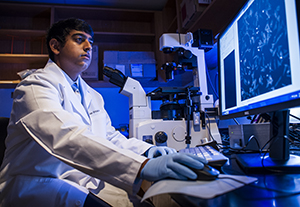 Dhruv Patel is working on a bone tissue regeneration project in the lab of biomedical engineering professor Ho-Wook Jun. Biomedical engineers use their training in biology, math, and advanced problem solving to understand the human body, injury, and disease. They also develop new devices or treatments to cure diseases and repair diseased or damaged tissues, says Timothy Wick, Ph.D., chair of the Department of Biomedical Engineering.
Dhruv Patel is working on a bone tissue regeneration project in the lab of biomedical engineering professor Ho-Wook Jun. Biomedical engineers use their training in biology, math, and advanced problem solving to understand the human body, injury, and disease. They also develop new devices or treatments to cure diseases and repair diseased or damaged tissues, says Timothy Wick, Ph.D., chair of the Department of Biomedical Engineering.
"While biomedical engineers don't treat patients, they work with doctors, scientists, and engineers to solve complex problems that improve health-care delivery and better patients' lives," Wick says. "You feel like you are making a difference in the world every day."
Patel and other graduates from the UAB program could work in hospitals, pharmaceutical companies, biotech companies, or research labs. Average starting salaries range from $45,000-$55,000 for students who go directly to positions in industry, Wick estimates. Pay is higher for those who move on to advanced degrees, including UAB's own master's and doctoral programs in biomedical engineering. The U.S. Bureau of Labor Statistics predicts that job growth for biomedical engineers is "much faster than average." In 2012, Forbes magazine named biomedical engineering to the top of its list of most valuable college majors, noting that the Bureau of Labor Statistics projected mid-career earnings to average $97,800.
Many UAB BME majors go on to medical school or other graduate programs, Wick says. Counting entry into graduate school, medical school, dental school, and other specialized higher degrees, the placement percentage for graduates is "more than 95 percent for the past 10 years," Wick says.
Learn More
See the biomedical engineering undergraduate concentrations and curriculum and learn about the fifth-year master's program
4. Forensic Accounting
Forensic accountants are the detectives of the spreadsheet set. They dig into one of the costliest problems in the global economy: occupational fraud in business. "According to a 2012 study by the Association of Certified Fraud Examiners, the typical organization loses 5 percent of its revenues to fraud each year," says Arline Savage, Ph.D., professor of accounting in the Collat School of Business. "Applied to the estimated 2011 Gross World Product, this figure translates to a potential projected global fraud loss of more than $3.5 trillion." Those numbers explain why "fraud fighters are in demand by organizations worldwide," says Savage.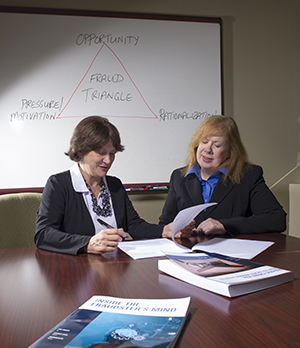 Former journalist Joan Ladd (right, with accounting professor Arline Savage) is turning her investigative eye to the growing field of forensic accounting. UAB's forensic accounting program, introduced in 2005, equips students with accounting, auditing, and investigative skills to track white-collar crime such as employee, financial statement, bank, insurance, health care, computer and tax frauds, Savage says. "They also prepare litigation support for criminal cases or civil legal disputes, which could result in providing expert testimony in court."
Former journalist Joan Ladd (right, with accounting professor Arline Savage) is turning her investigative eye to the growing field of forensic accounting. UAB's forensic accounting program, introduced in 2005, equips students with accounting, auditing, and investigative skills to track white-collar crime such as employee, financial statement, bank, insurance, health care, computer and tax frauds, Savage says. "They also prepare litigation support for criminal cases or civil legal disputes, which could result in providing expert testimony in court."
Since the terrorist attacks of September 11, 2001, "forensic accountants have also played a major role in following the financial trail of terrorists around the world," Savage adds. Many graduates from UAB's program go to work for traditional accounting firms, but they also find positions with health-care firms, insurance companies, and banks. They can also become special agents for the Federal Bureau of Investigation and Internal Revenue Service.
When Joan Ladd, who has an undergraduate degree in journalism and worked as a reporter at the Tuscaloosa News for almost 10 years, decided on a career shift, she was excited to find a new outlet for her investigative skills. "I am interested in fraud investigation and was fortunate to live near a university that offered an opportunity to study forensic accounting in-depth as a separate concentration," Ladd says. She is enrolled as a post-baccalaureate student at UAB working on her accounting equivalency.
Ladd says her favorite part of the program so far has been a summer Forensic Accounting Practicum with Savage, which was held at Birmingham accounting firm Warren Averett. Students were given a hypothetical fraud situation, along with a binder and thumb drive containing financial documents. "Along with several interviews we conducted in a class session, we had to analyze this information to develop a report of our findings," Ladd says. "It was a very challenging class, and called upon everything I had learned in the three previous forensic accounting courses."
Learn More
See the forensic accounting curriculum and requirements
5. Public Health
UAB's newest unique-in-Alabama program offers an important foundation for the future, says Max Michael, M.D., dean of UAB's School of Public Health. The bachelor's in public health, introduced in 2013, "will be one of the most important degrees in the 21st century because students will learn to take on some of the most complex problems imaginable," he explains. "They also will have a toolbox of resources to help solve them, and they will have a global perspective. These are three characteristics you won't get with many other degrees." Asia Sullivan was drawn to UAB's new undergraduate major in public health because of its crucial relevance to modern life.Students in the program learn to plan and manage health-care programs and study solutions to major health problems at local, national, and international levels. The major offers concentrations in environmental health sciences, global health studies, and public health preparedness.
Asia Sullivan was drawn to UAB's new undergraduate major in public health because of its crucial relevance to modern life.Students in the program learn to plan and manage health-care programs and study solutions to major health problems at local, national, and international levels. The major offers concentrations in environmental health sciences, global health studies, and public health preparedness.
Sophomore Asia Sullivan was attracted to the new major "because it's a very interdisciplinary field of study," she says. "I see public health measures relating to what I study put to use every day and am proud to be part of something so important to society."
Students with a public health degree will be in demand, says undergraduate program manager Nicole Gravitt. The Association of Schools and Programs of Public Health estimates a shortage of 250,000 public health workers across the nation by 2020. Graduates can pursue positions with local, state, or federal government agencies, nonprofit organizations, advocacy groups, hospitals and clinics, community centers, and research or education settings. "We also anticipate a fair number of students going into professional schools and graduate programs," including UAB's master's program in public health, says Gravitt.
Learn More
See curriculum requirements and learn more about degree concentrations
More Information
Learn more about scholarships, financial aid, and college costs